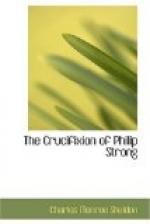The trial of the man with the hare-lip had been postponed for some legal reason, and Philip felt relieved somewhat. He dreaded the ordeal of the court scene. And one or two visits made at the jail had not been helpful to him. The man had refused each time to see the minister, and he had gone away feeling hungry in his soul for the man’s redemption, and realizing something of the spirit of Christ when he was compelled to cry out: “They will not come unto me that they might have eternal life.” That always seemed to Philip the most awful feature of the history of Christ—that the very people he loved and yearned after spit upon him and finally broke his heart with their hatred.
He continued his study of the problem of the town, believing that every place has certain peculiar local characteristics which every church and preacher ought to study. He was struck by the aspect of the lower part of the town, where nearly all the poorer people lived. He went down there and studied the situation thoroughly. It did not take a very great amount of thinking to convince him that the church power in Milton was not properly distributed. The seven largest churches in the place were all on one street, well up in the wealthy residence portion, and not more than two or three blocks apart. Down in the tenement district there was not a single church building, and only one or two weak mission schools which did not touch the problem of the district at all. The distance from this poor part of the town to the churches was fully a mile, a distance that certainly stood as a geographical obstacle to the church attendance of the neighborhood, even supposing the people were eager to go to the large churches, which was not at all the fact. Indeed, Philip soon discovered that the people were indifferent in the matter. The churches on the fashionable street in town meant less than nothing to them. They never would go to them, and there was little hope that anything the pastor or members could do would draw the people that distance to come within church influence. The fact of the matter was, the seven churches of different denominations in Milton had no living connection whatever with nearly one-half the population, and that the most needy half, of the place.
The longer Philip studied the situation, the more un-Christian it looked to him, and the more he longed to change it. He went over the ground again and again very carefully. He talked with the different ministers, and the most advanced Christians in his own church. There was a variety of opinion as to what might be done, but no one was ready for the radical move which Philip advocated when he came to speak on the subject the first Sunday of the month.




